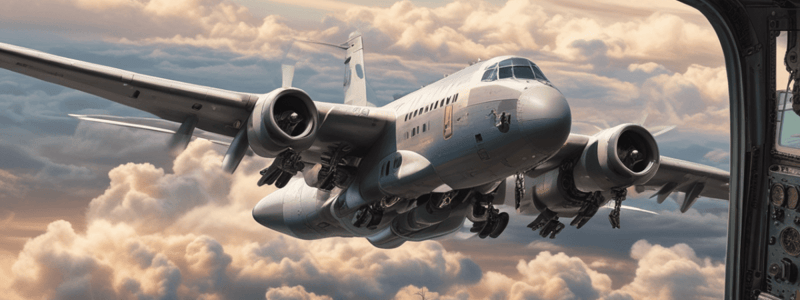Podcast
Questions and Answers
What is the primary function of the Central Maintenance Computer (CMC)?
What is the primary function of the Central Maintenance Computer (CMC)?
- To initiate self-tests in flight mode
- To acquire and process data from BITE memories (correct)
- To display output messages from systems
- To control the interrelated systems
What are the two modes of operation of the Central Maintenance System?
What are the two modes of operation of the Central Maintenance System?
- Normal and menu mode (correct)
- Flight and ground mode
- Real-time and self-test mode
- Automatic and manual mode
What can be initiated via the MCDU in menu mode?
What can be initiated via the MCDU in menu mode?
- Real-time monitoring and data logging
- Flight planning and navigation
- Self-tests and troubleshooting (correct)
- System reconfiguration and updates
What type of data is memorized by the system computers and CMCs?
What type of data is memorized by the system computers and CMCs?
What is the purpose of the Multipurpose Control and Display Units (MCDUs)?
What is the purpose of the Multipurpose Control and Display Units (MCDUs)?
In which mode is the CMS available for self-tests and troubleshooting?
In which mode is the CMS available for self-tests and troubleshooting?
What happens when a discrete input is permitted in a Type 3 system?
What happens when a discrete input is permitted in a Type 3 system?
Where do aircraft systems send their BITE information?
Where do aircraft systems send their BITE information?
What is the function of the Multifunction Control Display Unit?
What is the function of the Multifunction Control Display Unit?
What are self-tests used for in conjunction with the Aircraft Maintenance Manual (AMM)?
What are self-tests used for in conjunction with the Aircraft Maintenance Manual (AMM)?
How do operators access the CMC functions?
How do operators access the CMC functions?
What is stored in the non-volatile memories of the CMC?
What is stored in the non-volatile memories of the CMC?
What is the primary purpose of the Aircraft Communication Addressing and Reporting System (ACARS)?
What is the primary purpose of the Aircraft Communication Addressing and Reporting System (ACARS)?
What is the function of a data loader in an aircraft?
What is the function of a data loader in an aircraft?
What is the benefit of integrating the CMC with ACARS?
What is the benefit of integrating the CMC with ACARS?
What is the typical connection method for a data loader?
What is the typical connection method for a data loader?
What type of data can be downloaded from an aircraft using a data loader?
What type of data can be downloaded from an aircraft using a data loader?
What is the purpose of the CMC in an aircraft?
What is the purpose of the CMC in an aircraft?
What is displayed on the data loader LCD during the transfer?
What is displayed on the data loader LCD during the transfer?
What type of media did older data loaders typically use?
What type of media did older data loaders typically use?
What is the typical number of paper pages of integrated text and graphics that an airliner usually comes with?
What is the typical number of paper pages of integrated text and graphics that an airliner usually comes with?
How is software loaded into the target hardware?
How is software loaded into the target hardware?
What should be recorded after loading Field Loadable Software (FLS)?
What should be recorded after loading Field Loadable Software (FLS)?
What type of documents are used for operational requirements in an airliner?
What type of documents are used for operational requirements in an airliner?
What is required after loading a Loadable Software Aircraft Part (LSAP)?
What is required after loading a Loadable Software Aircraft Part (LSAP)?
What is the name of the paperless cockpit concept that replaces traditional paper-based documentation?
What is the name of the paperless cockpit concept that replaces traditional paper-based documentation?
What type of data is typically stored in the Cabin Management Tools?
What type of data is typically stored in the Cabin Management Tools?
Where should a copy of the loaded FLS be kept?
Where should a copy of the loaded FLS be kept?
What is the main purpose of the Maintenance Applications in an airliner?
What is the main purpose of the Maintenance Applications in an airliner?
What is typically subdivided into Operational Requirements, Maintenance Applications, and Cabin Management Tools?
What is typically subdivided into Operational Requirements, Maintenance Applications, and Cabin Management Tools?
Flashcards are hidden until you start studying
Study Notes
Central Maintenance Computer (CMC) Functions
- The primary function of the CMC is to manage aircraft maintenance data and diagnostics.
- It supports system health checks and maintenance reporting to enhance operational efficiency.
Modes of Operation
- The Central Maintenance System operates in two modes: Normal mode and Maintenance mode.
- Normal mode allows routine operations, while Maintenance mode facilitates self-tests and troubleshooting.
Multipurpose Control and Display Units (MCDUs)
- MCDUs enable pilots to access various functions and information displays.
- In menu mode, users can initiate diagnostics, maintenance reports, and other system procedures.
Data Memorization
- System computers and CMCs memorize operational and maintenance data for easy retrieval.
- This includes fault codes, system performance metrics, and historical maintenance logs.
Purpose of MCDUs
- MCDUs serve as user interfaces for pilots to control and monitor aircraft systems.
- They provide critical flight data and access to the Central Maintenance System.
Self-Tests and Troubleshooting
- The Central Maintenance System is available for self-tests and troubleshooting in Maintenance mode.
- This allows for diagnosis of system issues before flight operations.
Discrete Inputs in Type 3 Systems
- In Type 3 systems, permitting a discrete input can trigger specific system responses and alerts.
- This facilitates real-time monitoring of critical aircraft parameters.
BITE Information Flow
- Aircraft systems transmit Built-In Test Equipment (BITE) information to the CMC for analysis.
- This allows for automatic monitoring and early detection of system failures.
Multifunction Control Display Unit Function
- The Multifunction Control Display Unit consolidates various display functions into one panel.
- It enhances operational efficiency by providing crucial information at a glance.
Self-Tests and Aircraft Maintenance Manual (AMM)
- Self-tests are used to validate system functionality and are referenced alongside the AMM for troubleshooting.
- This integration helps technicians follow systematic procedures during maintenance checks.
Accessing CMC Functions
- Operators access CMC functions through pilot interfaces, primarily via the MCDU.
- This setup ensures intuitive access to maintenance and diagnostic tools during operations.
Non-Volatile Memory Content
- Non-volatile memories within the CMC store critical software and operational data.
- This ensures data persistence even when the aircraft is powered off.
ACARS Purpose
- The Aircraft Communication Addressing and Reporting System (ACARS) primarily facilitates automatic data exchange.
- It enables the transmission of aircraft performance, maintenance, and operational data to ground stations.
Data Loader Functionality
- The data loader in an aircraft is used to upload software and operational data.
- It serves as a critical tool for updates and equipment configuration.
CMC and ACARS Integration Benefits
- Integration of the CMC with ACARS enhances real-time monitoring and reporting capabilities.
- It allows for timely interventions based on incoming data from the aircraft.
Data Loader Connection Methods
- Typically, a data loader connects via a serial interface or wireless communication.
- This facilitates easy transfer of data without physical connectors.
Data Download Capabilities
- A data loader can download operational data, fault codes, and system performance logs from the aircraft.
- This information is vital for maintenance and troubleshooting.
CMC Purpose in Aircraft
- The CMC’s main purpose is to streamline maintenance operations and enhance aircraft reliability.
- It acts as a central hub for managing aircraft diagnostics and reporting.
Data Loader LCD Displays
- During data transfer, the data loader LCD displays progress and status updates on the operation.
- This ensures users are informed about the transfer status and any potential issues.
Older Data Loader Media
- Older data loaders typically used magnetic tape or floppy disks for data storage and transfer.
- These media types have since been largely replaced by modern digital solutions.
Airliner Documentation Volume
- An airliner usually comes with around 1000 pages of integrated text and graphics documenting operational requirements.
- This documentation supports maintenance and flight operations.
Software Loading Process
- Software is loaded onto target hardware through a systematic upload process managed by the data loader.
- This method ensures integrity and compatibility of the software with the aircraft systems.
Field Loadable Software (FLS) Record Keeping
- After loading FLS, it is crucial to document the details for maintenance records.
- This ensures tracking of software versions and compliance verification.
Operational Requirements Documentation
- Operational requirements in an airliner are documented using standard operational manuals and procedures.
- These documents guide flight and maintenance crews in everyday operations.
Loadable Software Aircraft Part (LSAP) Requirements
- After loading an LSAP, technicians must conduct verification checks to ensure proper installation.
- This step is essential for maintaining system integrity and functionality.
Paperless Cockpit Concept
- The paperless cockpit concept replaces traditional documentation with electronic displays and access.
- This innovation improves efficiency and reduces physical clutter in the cockpit.
Cabin Management Tools Data
- Cabin Management Tools typically store data related to in-flight entertainment and passenger services.
- This information is crucial for ensuring a pleasant passenger experience.
Loaded FLS Documentation Storage
- A copy of the loaded FLS should be kept in the aircraft maintenance records for reference.
- This practice ensures traceability and accountability in software management.
Maintenance Applications Purpose
- Maintenance applications in an airliner help streamline and document maintenance processes.
- They improve efficiency and ensure compliance with regulatory standards.
Data Subdivisions in Airliner Systems
- Systems are typically subdivided into Operational Requirements, Maintenance Applications, and Cabin Management Tools for efficient management.
- This structure helps distinct purposes while providing comprehensive support for operations.
Studying That Suits You
Use AI to generate personalized quizzes and flashcards to suit your learning preferences.




